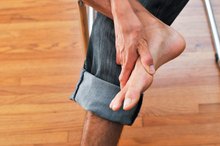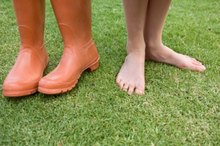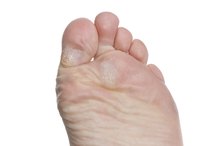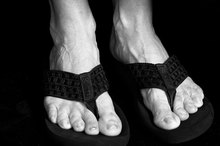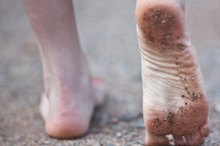What does fact checked mean?
At Healthfully, we strive to deliver objective content that is accurate and up-to-date. Our team periodically reviews articles in order to ensure content quality. The sources cited below consist of evidence from peer-reviewed journals, prominent medical organizations, academic associations, and government data.
The information contained on this site is for informational purposes only, and should not be used as a substitute for the advice of a professional health care provider. Please check with the appropriate physician regarding health questions and concerns. Although we strive to deliver accurate and up-to-date information, no guarantee to that effect is made.
How to Get Rid of Corns on the Bottoms of the Feet
A corn is a type of callus that can form anywhere on the foot. Typically, corns grow because of friction or pressure. People can get corns on any part of the foot that protrudes. Repetitive action causes skin to thicken and grow in hard layers. Possible causes of corns can be poorly fitted shoes, walking barefoot or not wearing socks. For the most part, a corn is harmless, but they can cause great discomfort on places like the bottom of the foot. Treating a corn takes time and requires you to remove the source of the friction.
Soak your foot in warm, soapy water. Use a mild cleanser if you have sensitive skin, otherwise any soap, even dish soap, is fine. Soak for five to 10 minutes.
How to Remove Corns Permanently
Learn More
Place a towel on the floor to catch flaking skin. Set your wet foot on top of the towel.
Rub over the bottom of the foot with a pumice stone, focusing on the callus. This will scrub off the hardened layers of skin. Do not use a pumice stone if you have an infection or are prone to them.
How to Remove Foot Corns Naturally
Learn More
Apply a lotion or cream to the affected area. This will soften the skin and keep the corn from cracking.
Use a pad to cover the area such as a self-adhesive gauze bandage. MayoClinic.com warns against applying corn removers or medicated pads since they contain chemicals that can irritate skin 1.
Remove the source of the pressure. For instance, if you wear shoes without socks, start wearing socks to reduce friction.
Warnings
Never try to shave off a corn. This will break the skin and might result in an infection. Diabetics are at high risk of infection because of circulatory problems, especially in appendages such as the feet. Corns or calluses that develop on the feet of diabetics require medical treatment. Attempting to remove the corn on the bottom of the foot of a diabetic might result in a sore that will not heal or might develop into a life-threatening infection such as gangrene.
Related Articles
References
- MayoClinic.com: Corns and Calluses
- University of Maryland Medical Center: Diabetes: Taking Care of Your Feet
- DeLauro T and DeLauro M (2012) Chapter 98: Corns and Calluses. Fitzpatrick's Dermatology in General Medicine (8th Edition). New York, New York: McGraw-Hill Education. ISBN-13: 978-0071669047.
- American Academy of Dermatology Association. How to treat corns and calluses. 2019.
- Reddy P, Anusha T, Haritha N, Nagendra A, Bhavani D, Gandhimathi R. Case report on non-surgical treatment for foot corn. International Journal of Dermatopathology and Surgery. 2018;4(1).
- American Academy of Dermatology Association. How to Treat Corns and Calluses. 2019.
- DeLauro T and DeLauro M (2012) Chapter 98: Corns and Calluses. Fitzpatrick's Dermatology in General Medicine (8th Edition). New York, New York: McGraw-Hill Education. ISBN-13: 978-0071669047.
Writer Bio
Writing since 1999, Darla Ferrara is an award-winning author who specializes in health, diet, fitness and computer technology. She has been published in "Mezzo Magazine" and Diet Spotlight, as well as various online magazines. Ferrara studied biology and emergency medical technology at the University of Nebraska and Southeast Community College.
